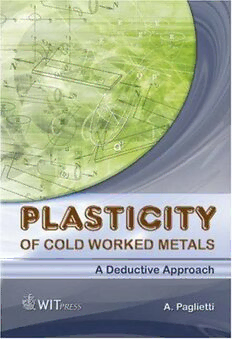
Plasticity of Cold Worked Metals: A Deductive Approach PDF
193 Pages·2007·1.265 MB·English
Most books are stored in the elastic cloud where traffic is expensive. For this reason, we have a limit on daily download.
Preview Plasticity of Cold Worked Metals: A Deductive Approach
Description:
Plasticity Theory is a basic tool of structural analysis used to evaluate ultimate strength and post-elastic behaviour of ductile structures. Modern computing codes make use of it, often by exploiting sophisticated computational analysis and advanced kinematics for large deformation. Yet all this valuable effort has its Achilles heel: the evolution law of the yield surface, also referred to as the work-hardening rule. This book approaches the work-hardening problem in a new and deductive way. It starts with a few elementary, hardly questionable facts and works out their inescapable consequence, following them through until a practical solution is obtained. The analysis it presents will show that plastic yielding of ductile metals is essentially virgin yielding - no matter how strong the material was cold worked originally. Main Features - Derives all subsequent yield surfaces of ductile metals deductively, from the knowledge of the virgin yield condition of the material. - Teaches how to formulate realistic work hardening rules for general deformation processes (full three axial case included). - Provides a logical basis to interpret and design experiments to test the evolution of the yield surface of elastic-plastic materials. - Gives a practical tool to account for the anisotropy of the yield limit following plastic deformation. Audience Researchers, code designers and post-graduate students in the field of Mechanics of Solids and Mechanical and Structural Engineering; specialists in Plasticity Theory. Table of content Logical premises to subsequent yielding. Plastic yielding under deviatoric energy control. Geometric representation of strain and strain energy. The elastic range of the matrix. Subsequent yield surfaces of von Mises materials. The work hardening rule. Flat bars and thin-walled tubes after uniaxial plastic prestraining. Rotation tensors. Anisotropic past strain effect.
See more
The list of books you might like
Most books are stored in the elastic cloud where traffic is expensive. For this reason, we have a limit on daily download.
